Adding wood to your aquarium has quite obvious aesthetic benefits which can really transform the look of your tank. However there are other significant benefits too. Aquarium wood can give secretive species a place to live and hide. It can serve as a spawning site for egg laying species. Wood can even provide a food source of algae and small microscopic animals collectively known as aufwuchs for some difficult to keep species of catfish and subject to the type alter your water chemistry helping you to achieve the correct water parameters for your species of choice.
There are various types of wood available from stores, retailers and your own garden which are suitable for decorative use in your aquarium. Buying from a specialist retailer will ensure that the wood you choose is fit for purpose, but if you take a little time to research suitable species you may be able to collect wood from your own garden or somewhere else where you have been given permission to source wood.
Jared Cave of Biotope Aquatics describes some of the commonly available types of exotic aquarium wood for use in your aquarium, while Simon Morgan of the British Cichlid Association advises on native hardwood species that you can collect yourself.
Bogwood

Without doubt the most commonly used type of aquarium wood anywhere in the world. Bogwood is wood that has been preserved by the anaerobic conditions of these environments over hundreds if not thousands of years in a bog. It is discoloured by the tannins found in the bog over this lengthy period.
Genuine bogwood is now hardly ever seen for sale in the aquatics trade at the time of writing (2015) due to its expense. Instead wholesalers offer various types of wood which have been dried outdoors without the preservation process of true bogwood.
It comes in many shapes and sizes and is often used as an attractive natural looking ornament in the aquarium. Other benefits include providing hiding places for reclusive species, helping form natural boundaries for territorial species and it can be used as an anchor point for attaching aquarium plants such as Java Moss, Java Fern and Anubias barteri, further improving the aesthetic appeal of your tank.
Bogwood contains tannins (organic material) that will leach into your water giving it a tea coloured and stained colouration. This is perfectly harmless. In fact some aquarists even find it desirable when trying to recreate Amazonian black water conditions etc. Unfortunately there is no way to be sure how much tannin a piece of bogwood will leach or how long it will continue to leach it for.
If this doesn’t bother you then add it to your tank and don’t worry. If you want to minimise the amount of tannin leached into your aquarium then soak it for one to four weeks in a bucket of water, changing all of the water regularly. You should start to see the amount of tannin decline over time which will give you an idea as to when you can add it to your tank.
If your wood has stained the water in your tank more than you would like you can reduce the discolouration with regular water changes and the use of activated carbon in your filter.
When deciding if you want to pre-soak your wood first you may want to bear in mind that tannins will lower your pH just like peat can do so it may be wise to monitor this and buffer your water accordingly if required. The tannins are also reported to act as a very mild fungicide with antibacterial properties.
Quite often a white fungal like growth can be seen leaching from bogwood after its addition to the aquarium. This is perfectly harmless and will stop doing this within a few weeks. The aquarist can either choose to remove the wood and scrub it off if they wish or leave it. Some algae loving herbivorous fish species will actually eat it.
Bogwood should be added to aquaria housing species of ‘wood eating catfish’. These fish do not actually digest the wood which is expelled as waste, but do digest the associated organic material when scraping the surface of wood with their teeth such as algae, animals and microscopic plants collectively known as aufwuchs.
Bogwood comes from several species of tree including oak, pine and yew with colours varying from a rich reddish brown (pine) to jet black (oak) with hues of dark brown in between (yew).
Some bogwood is offered for sale as ‘pre-soaked’, though this is actually quite rare due to the additional time and expense required. It is best to assume that your bogwood has not been pre-soaked and treat it yourself to obtain the desired effect.
Mopani Wood
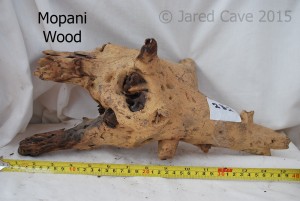
Mopani wood is sometimes referred to as ‘bogwood’. However this isn’t strictly accurate as it has never been anywhere near a bog! Instead Mopani wood comes from the Mopane tree (Colophospermum mopane) which originates from Sub Saharan Africa.
Mopani wood is heavy and hard, so hard in fact that it is termite resistant. It’s attractive and somewhat gnarled appearance have caused it to gain popularity as a heavy decorative wood not just in aquaria but also as a base for lamps and sculptures. Before being offered for sale in retail aquatic stores it is sandblasted removing all of its bark. This process gives it a two tone appearance as can be seen from the in the picture.
Mopani wood can also leach tannins and produce a fungal growth just like regular bogwood so the points about removal and treatment for regular bogwood apply to Mopani wood also. Always thoroughly soak mopani wood before adding it to your aquarium.
Redmoor Wood
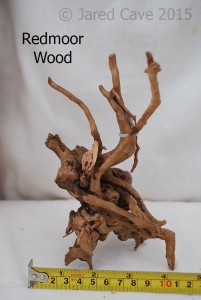
Arguably a lot more aesthetically pleasing than either bogwood or Mopani wood, redmoor wood with its reddish hues and tangled root appearance can be used to give a striking centrepiece in your aquarium.
The downside is that it can be considerably more expensive than other types of aquarium wood, but many pieces justify this because of its visual beauty alone. Further positives are that it doesn’t seem to leach anywhere near as much tannin as other aquarium woods and I’m yet to see a single piece become covered in fungal growth. It does however need a thorough soaking to ensure that it sinks. It is not as heavy and dense as Mopani wood and sometimes requires a lengthy soaking to get it to sink. Very occasionally it may even require holding in place with a rock, though this is very rare.
Sumatran Driftwood
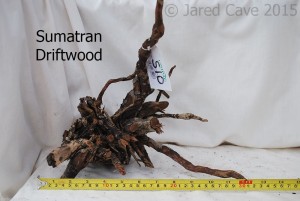
This driftwood is actually pieces of cut mangrove root. Pieces vary in size between around 25cm to 150cm for very large tanks. It is often used by aquascaping fans as a central piece of hardscape. Like redmoor wood it doesn’t seem to release tannins but occasionally is subject to fungal growth. It also sometimes requires a thorough soaking before it will sink. This process may take a week or so.
The distributor claims that it is harvested in an ethical manner from dead trees in the Far East before being sandblasted and cut to shape. Sandblasting gives it a very smooth texture.
Marsh Root
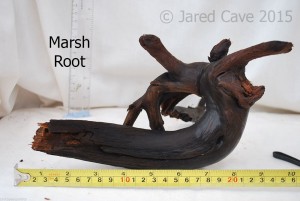
Originating in Eastern Europe, marsh root wood is the roots of hardwood trees that have been soaked in boggy conditions for some time. It has not been preserved like genuine bogwood, but has been soaked long enough so that tannins no longer leach from it. It’s dark brown to black colouration can be very striking when placed on a light coloured substrate.
It is guaranteed not to float, is sold in various sizes and as well as not discolouring your water, it will not alter your pH at all. It is marketed at those keeping wood eating catfish species.
Azalea Root
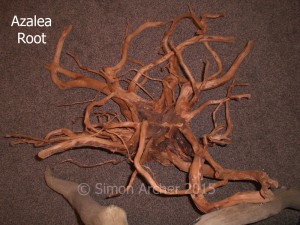
Azalea root is sometimes known as as spider wood when offered for sale. It floats so needs soaking but doesn’t give off tannins or change the pH. It might create a bloom or biofilm/fungal growth but not always. Some sellers bake it before shipping to treat it for use in the aquarium.
It’s an attractive golden brown colour, and as the nickname of spider wood suggests, it’s quite a tangly looking wood. This makes it a visually interesting addition, as well as offering hiding places for smaller fish.
Using wood collected from nature in the aquarium
It’s perfectly safe to collect wood from nature and use it in an aquarium. Just make sure you identify the tree properly and prepare the wood properly. A good website for tree identification is:
Woodlands.co.uk – tree identification
Safe woods for use in an aquarium
- Alder
- Apple
- Beech
- Birch
- Cherry
- Hawthorn
- Heather
- Oak
- Pear
- Sycamore
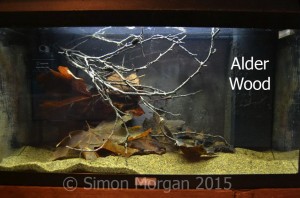
Unsafe woods for use in an aquarium
- Cedar (avoid anything evergreen/coniferous)
- Cypress
- Grape vine – this rots very quickly
- Horse chestnut
- Lilac – this is poisonous
- Ivy – this is poisonous
- Pine
- Spruce
- Walnut
- Yew – this is toxic
You’ll note that yew and pine are safe in the form of bogwood, unfortunately it will take longer than your lifetime for you to replicate the conditions that has made them safe, so please avoid them when collecting wood yourself.
Collecting and preparing wood for use in your aquarium
Remember to collect wood from rural areas and make sure you have permission. Look for dry pieces with no mould, rot or fungus. It’s also fine to take “cuttings” from living trees but again, make sure you have permission or make friends with a tree surgeon.
I prefer to dry out newly cut or collected wood for a couple of weeks to remove any remaining sap, then soak it. Soaking isn’t always necessary but helps the wood to sink and the bark to peel off more easily. Removing the bark is optional.
The best time to collect wood is late summer. Go to a deciduous forest and look for beech and oak. During the summer the larger trees actually drop branches to protect themselves from dehydration. These branches are usually dry and have dropped recently so haven’t started to rot. You can also find fresh wood following a storm.
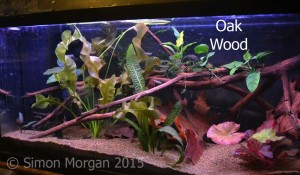
Drift wood from a beach, for example, is not going to have pathogens that can infect freshwater fish. However, chances are it’s been floating around the ocean for months or even several years. It’s not going to sink any time soon, so I suggest it’s not a good place to find wood. If you do find a piece you like and would like to try it, I suggest soaking it, fully immersed, in freshwater for about a month. If it sinks after that, it is probably OK to use, but there is some unknown risk to bear in mind, especially if you can’t identify it. Bear in mind that it may have picked up pollutants such as oil while drifting, so unless you are certain of its provenance it may not be wise to use it.
Author: Jared Cave (commercially available aquarium wood) and Simon Morgan (collecting your own wood).
Photos courtesy of: Jared Cave, Simon Morgan and Simon Archer




